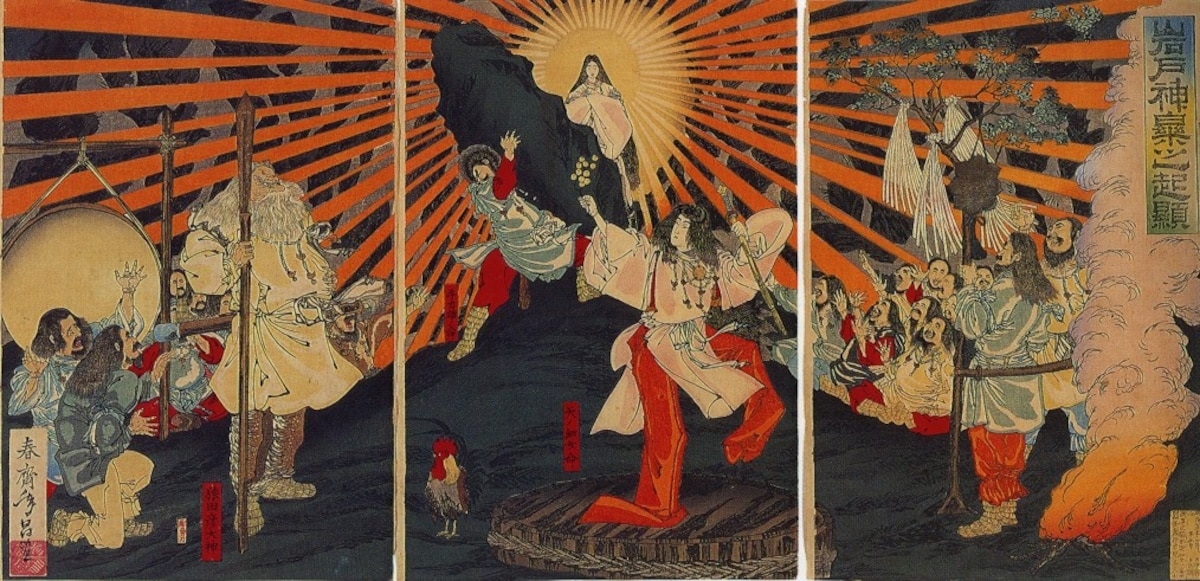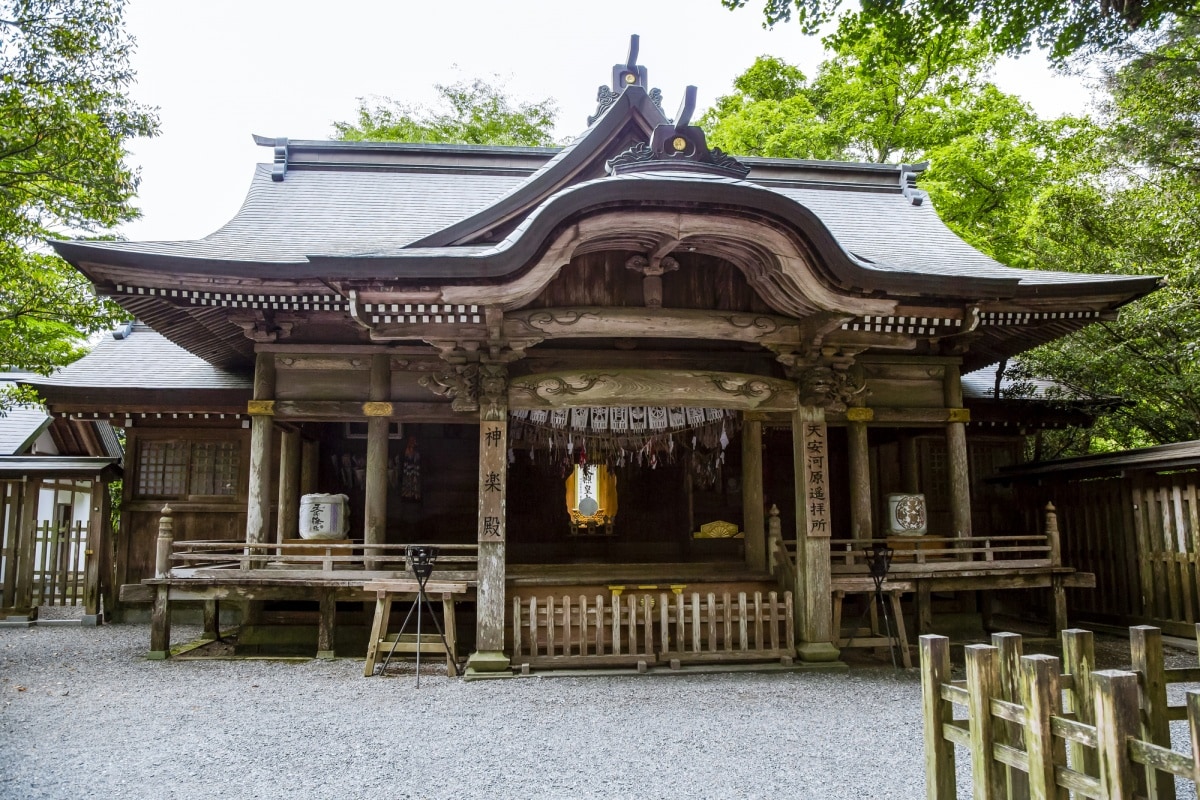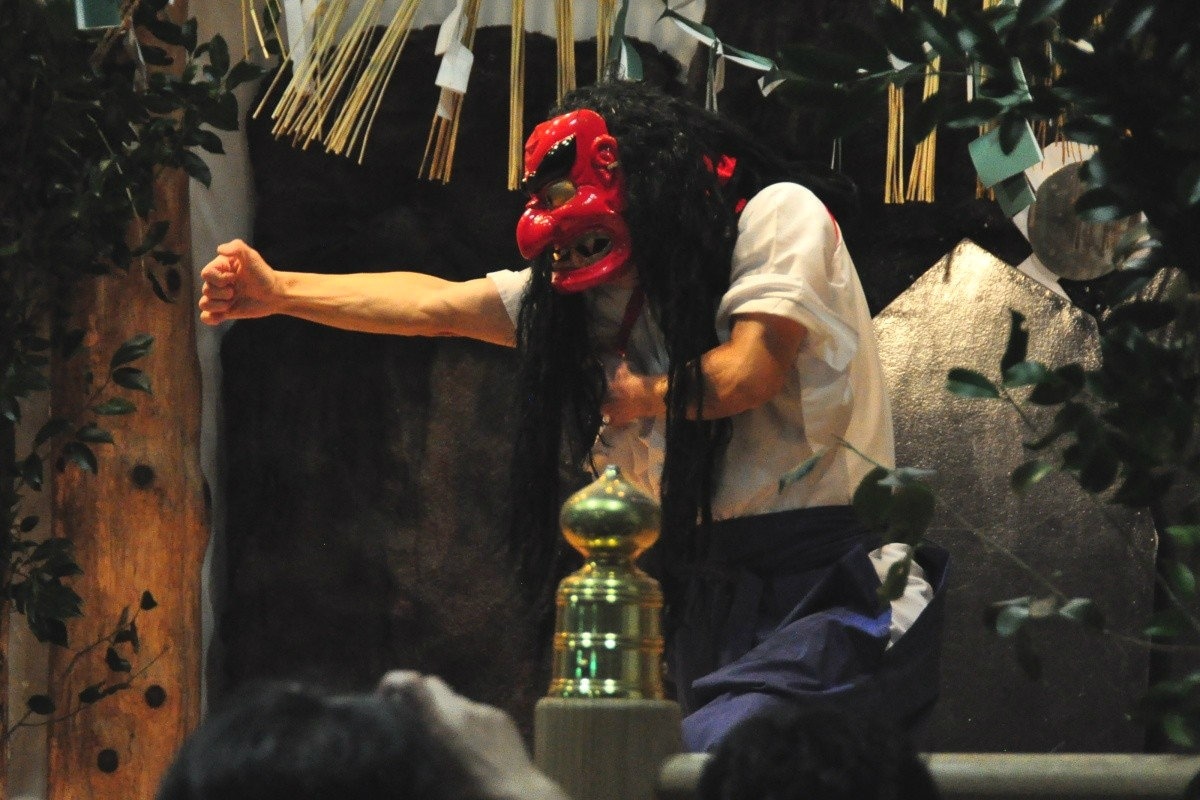Takachiho: Climb into the Land of the Gods
The town of Takachiho lies at the heart of many myths of Japan—and not without reason. Long inhabited, stone artifacts as old as 20,000 years have been found in the surrounding mountains, as well as earthenware from all six sub-divisions of the Jomon Period (14,000-300 B.C.).
By Michael KanertThe Imperial Line of the Sun

https://ja.wikipedia.org/wiki/%E5%A4%A9%E7%85%A7%E5%A4%A7%E7%A5%9E
Takachiho occupies the mountains of the northwestern corner of Miyazaki prefecture, bordering both Oita and Kumamoto to the north and west. In the Kojiki (古事記), the earliest known chronicle of Japan, the god Ninigi-no-Mikoto is said to have descended to earth and alighted upon Takachiho-no-Kushifurutake (高千穂の久士布流多気)—a site that has been interpreted to lie in the modern-day town of Takachiho (that said, the stronger claim is generally given to the mountain Takachiho-no-mine, located among the Kirishima Mountains on the southwestern edge of Miyazaki).
Sent to become lord of the Japanese islands, Ninigi-no-Mikoto was the great-grandfather of Jimmu, the legendary first emperor of Japan, and grandson of Amaterasu, the goddess of the sun, who is also strongly tied to Takachiho.
When the sun goddess was distressed by the unruly behavior of her brother, Susano-o, god of storms and the sea, she hid herself away in a cave, depriving the world of light. After deliberating what to do, all the other gods decided to hold a party outside the cave in an attempt to lure her out. The laughter elicited by a lewd dance performed by Ame-no-Uzume-no-Mikoto, goddess of the dawn, mirth and revelry, enticed the sun goddess to peek back outside.
In that instant, she became entranced by her own reflection in a bronze mirror that had been prepared for the purpose, and the powerful god Ame-no-Tajikarao pulled her out of the cave (or, alternatively, hefted away the stone that blocked the cave, or blocked the entrance with a stone). A shimenawa sacred cord was then placed over the entrance so Amaterasu could never hide herself away again.
Amanoiwato Shrine

https://pixta.jp/tags/%E5%A4%A9%E5%B2%A9%E6%88%B8%E7%A5%9E%E7%A4%BE?utf8=%E2%9C%93&page=1&sell_flat=1&rows=50&keyword=%E5%A4%A9%E5%B2%A9%E6%88%B8%E7%A5%9E%E7%A4%BE&exclude=&search_type=0&showTitle=true&showDetailOn=true&option%5Bis_japanese%5D=&option%5Bs
Amaterasu’s cave, Amanoiwato (天岩戸), is believed to be located in Takachiho. It is venerated at the Nishihongu (West Main Shrine) of Amanoiwato Shrine, which comprises a series of structures sprawling along the edge of a gorge above the small Iwato River.
After participating in a Shinto purification ritual, visitors can progress to an observation deck behind the shrine’s main building to catch a glimpse of the cave. Located in the cliff face across the river, it’s rather hard to spot, and no pictures are allowed.
Amanoyasukawara
Roughly 500 meters (547 yds) upstream from Amanoiwato Shrine, you can also explore Amanoyasukawara (天安河原), the cave where Japan’s 8 million gods gathered to deliberate how to get Amaterasu to come out.
A large, atmospheric opening situated directly on the river’s edge, you can hike all the way down and take all the pictures you like. The cave is filled with little stacks of stones arranged by visitors to the shrine with the hope of having their wishes come true, a tradition that only seems to have sprung up in the post-war period.
Yokagura
Ame-no-Uzume-no-Mikoto’s dance is credited as the origin of kagura, a form of ritual dance most notable for its use of masks. Takachiho is known for a specific form of the dance called yokagura, or night kagura. Consisting of 33 dances performed throughout the night, full yokagura performances are held at different locations in town over 20 days between mid-November and early February.
If, like most tourists, you’re not up for a full night of Shinto revelry, you might instead elect to see a selection of four yokagura dances from 8 p.m. to 9 p.m. nightly at the Kagura Hall at Takachiho Shrine (¥700). Accompanied by flute and drum, the four dances include the Dance of Tajikarao (the god who opened the cave) and the Dance of Uzume (the goddess who caused the laughter), as well as the Totori Dance, which represents the removing of the door to Amanoiwato.
https://www.youtube.com/watch?v=S4WipCRWRwY
The final dance, the Goshintai Dance, depicts Izanagi and Izanami, the god and goddess whose children are said to have formed the islands of Japan. In the dance, they make and drink sake, with the result that they meander drunkenly through the audience, bringing the hour to a light-hearted conclusion.
Be sure to arrive early, as the space fills quickly. You may want to bring a cushion (zabuton) to sit on, since the floor is only tatami.
Takachiho Shrine
Takachiho Shrine stands in a grove of huge cryptomeria trees, some believed to be 800 years old. The unpainted structure of the main hall is particularly atmospheric when the surrounding lanterns are lit at night.
The shrine enshrines the deities of the other 88 main local shrines in the area. The main hall and a pair of iron guardian dog statues (which you can see through the windows on the wings of the main hall) are nationally designated Important Cultural Properties.
The shrine is also noted for a pair of “wedded cedars,” two trees with interwoven roots connected by a shimenawa cord. Walking hand-in-hand around the trees three times is said to bring a couple marital bliss.
Takachiho Gorge
While Takachiho Gorge (高千穂峡・Takachiho-kyo) has nothing to do with local legends, it has everything to do with the largest geologic feature in the region. The gorge has been cut out of an ancient lava flow from Mount Aso, the largest active volcano in Japan, with jagged columns of basalt rising up from the placid green face of the Gokase River.
While the gorge can be seen from above from both a bridge and a walking trail, the best way to experience it is from a rowboat (¥2,000 for 30 minutes). On a busy day, the narrow gorge is crowded with boaters jockeying for the best view of the 17-meter (56 ft) Manai Falls. Arrive around noon to get a view of the light filtering down through the cascading veil of water. Just be sure to watch your time—and be careful not to let your boat drift under the falls!
Fireflies appear along the gorge in June, and from mid-July to early September, the falls are illuminated until 10 p.m.
Takachiho Three-Stage Bridge
The overlapping of these three bridges is worth a quick look, including Shinbashi Bridge, Takachiho Bridge and the newer Shinto Takachiho Bridge. They can be seen on the way to Kunimigaoka.
Kunimigaoka
Kunimigaoka (国見ケ丘) is a lookout point 513 meters (1,683 ft) above sea level. It received its name thanks to a visit from Emperor Jimmu's grandson, Tateiwatatsu-no-Mikoto, who noted the panoramic view afforded in all four directions, after which the spot came to be known as Kunimigaoka ("Country Gazing Hill").
To the northwest can be seen the peaks of Mount Aso, which, from this vantage point, resemble a reclining Buddha (阿蘇涅槃像・Aso Nehanzo), with Mount Neko forming the face. Head out early on a cool, windless morning from late September to early November for a chance to see a sea of clouds (雲海・unkai) below you. The spot is also popular for catching the first light on New Year’s Day.
Stop in at the visitors’ center for some free shiitake tea, which has a salty flavor that makes it taste almost like soup.
Getting Around
It’s well worth your while to invest ¥10,000 in a taxi tour. While Takachiho Shrine and Takachiho Gorge are walkable from the bus center (about 15 minutes to the shrine and a further 15 to the gorge), everything else is only accessible by car or bus.
Not only will a taxi let you hit all the key sights in a single day, your taxi driver will offer a wealth of local knowledge and effectively act as a private tour guide. Their English may be limited, however. If needed, there is an English telephone interpretation service available from 8 a.m. to 6 p.m. (signs are up in the bus center).
Food

https://www.flickr.com/photos/fui/12352002/
If you’re feeling hungry, try to eat around Amanoiwato Shrine or Takachiho Gorge. Otherwise, if your accommodation does not offer meals, there’s very little in the way of restaurants in town. Your best bets in the evening would be the big drug and grocery store across from Takachiho Shrine, and the small noodle shop and café nearby.
Access
A 2005 typhoon destroyed two bridges on the Takachiho Railway, and nobody has been able to raise sufficient funds to replace them. As a result, the town has been inaccessible by train ever since, with the nearest train station at Nobeoka, roughly 80 minutes away by bus.
Another option is to get a direct bus from Miyazaki, but there’s just one bus that leaves at 8:40 a.m. on weekends and most holidays. The bus is quite spacious, however, and tickets must be purchased in advance from the bus center at the base of JR Kyushu Hotel Miyazaki. Boarding at bus stand C on the west side of Miyazaki Station, it takes 2 hours and 40 minutes to get to Takachiho. There’s just one return bus at 3 p.m.
If you’re struggling with timing, there’s roughly one bus per hour to and from Nobeoka, no reservation required (it’s just a city bus). There are also two buses daily to Kumamoto Station (2.5 hours), and if you really want to push it, there are four buses a day to and from Hakata in Fukuoka Prefecture (3.5 hours).




